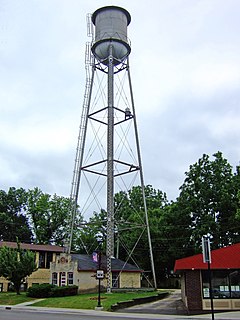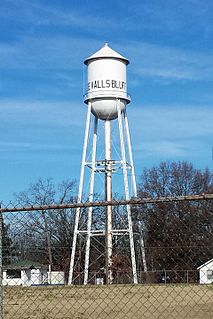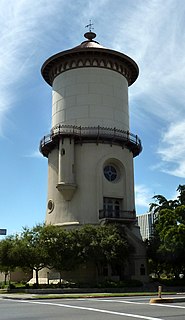
The Ypsilanti Water Tower is a historic water tower in Ypsilanti, Michigan, United States.

Lockesburg Waterworks are a water storage and distribution facility at the junction of Hickory and Azalea Streets in Lockesburg, Arkansas. The facility consists of a water tower and three water storage sheds, of which the tower was built in 1936 with funding assistance from the Public Works Administration, a Depression-era works project. The older shed was built in 1945, and the second was built in 1990. The tower is a metal structure with four legs supported and stabilized by cross bracing, with a metal tank at the top which is sheltered by a conical roof. The oldest shed is a modest square brick structure at the center of the complex, while the 1990 shed is located at the southwest corner of the property.

The Beaumont St. Louis and San Francisco Railroad Water Tank is a railroad water tank or water tower constructed in 1875, in Beaumont, Kansas. It served the St. Louis, Wichita & Western Railway, and was used to refill the boilers of steam locomotives on that line. It was added to the National Register of Historic Places in 1993. A sign at the site claims it was the last water tank used in regular railway operations in the United States.

Mackay Estate Water Tower is a historic water tower located in the Incorporated Village of East Hills in Nassau County, on Long Island, in New York, United States. The tower was originally a component of Clarence Mackay's Harbor Hill Estate.

The Oregon Water Tower and Pump House is a metal tower with a brick pump house built in 1899 in Oregon, Wisconsin. It was added to the National Register of Historic Places in 2007.

The Allen Hazen Water Tower, also known as the Municipal Water Tower, is a historic structure located on the west side of Des Moines, Iowa, United States. It was listed on the National Register of Historic Places in 2004.

The Pittsburgh-Des Moines Steel Company, and often referred to as Pitt-Des Moines Steel or PDM was an American steel fabrication company. It operated from 1892 until approximately 2002 when its assets were sold to other companies, including Chicago Bridge & Iron Company. The company began as a builder of steel water tanks and bridges. It also later fabricated the "forked" columns for the World Trade Center in the 1960s, and was the steel fabricator and erector for the Gateway Arch in St. Louis. A number of its works are listed on the National Register of Historic Places.

The Monette Water Tower is a historic structure located at the junction of Arkansas Highway 139 and Texie Avenue in Monette, Arkansas. It was built in 1936 by the Chicago Bridge & Iron Company in conjunction with the Public Works Administration as part of a project to improve the area's water supply. The Monette Water Tower is considered a good example of a 1930s-era elevated steel water tank. It was added to the National Register of Historic Places in 2008, as part of a multiple-property listing that included numerous other New Deal-era projects throughout Arkansas.

The McCrory Waterworks is a historic site located in McCrory, Arkansas. It contains an elevated steel water tower, built in 1936 by the Chicago Bridge & Iron Company in conjunction with the Public Works Administration, which provided $39,497 in aid for the construction of the waterworks, which included the water tower, tank, and water shed. The site was added to the National Register of Historic Places in 2007, as part of a multiple-property listing that included numerous other New Deal-era projects throughout Arkansas.

The De Valls Bluff Waterworks is a historic public water supply facility at Rumbaugh and Hazel Streets in De Valls Bluff, Arkansas. It contains a 1930s-era elevated steel water tower, built in 1936 by the Pittsburgh-Des Moines Steel Company in conjunction with the Public Works Administration as part of a project to improve the local water supply. It was added to the National Register of Historic Places in 2007, as part of a multiple-property listing that included numerous other New Deal-era projects throughout Arkansas. The property also contains several non-contributing buildings, including a shed, aeration chamber and water tank.

The Old Fresno Water Tower is a historic water tower in Fresno, California. It is listed on the National Register of Historic Places. Designed by George Washington Maher, the tower was completed in late 1894. It ceased operation in 1963 and has served as a visitors' center since 2001.

The Bearden Water Works are a historic public water works facility in Bearden, Arkansas, United States. It is located behind Bearden's city hall, at the corner of North 2nd Street and North Cedar Street, and consists of a water tower, two well houses, and a concrete holding tank. The facility was funded in 1936 by the Public Works Administration (PWA), and is the only PWA-built water works left in the county.

The Phillips County Penal Farm Historic District encompasses a former prison facility in Phillips County, Arkansas. It is located on the east side of County Road 353, south of United States Route 49, about halfway between Helena-West Helena and Marvell. The complex consists of three concrete structures, a water tower, and a concrete foundation pad. The main building is a cast concrete structure, two stories in height, with Plain Tradition and International styling, while the other two buildings are single-story concrete block structures. These, and the water tower, were built c. 1935–37 with funding from the Works Progress Administration, and served as a penal facility until 1973. The property is now vacant and abandoned.

The Hughes Water Tower is located on Church Street in Hughes, Arkansas. It is a metal structure consisting of four legs, sloping inward as they rise, which support a roughly cylindrical tower with bowl-shaped bottom and a conical roof. The legs are joined by reinforcing rods to provide stability. A large metal pipe connects the tank to water facilities on the ground, and there is a walkway with railing around the tank. The tower was built in 1936 by the Chicago Bridge and Iron Works Company with funding from the Public Works Administration.

The Keiser School is a historic school building at Main and School Streets in Keiser, Arkansas. It is a two-story brick and concrete structure with a rough T shape. The horizontal of the T houses classrooms and offices, while the extension to the rear houses the auditorium and gymnasium. The building has restrained Collegiate Gothic style, with a raised castellated parapet, and a pointed archway over the main entrance. It was built in 1929, and is a fine local example of the architectural style.

The Green Forest Water Tower is a historic water tower, located near the junction of South Springfield and East Second Streets in Green Forest, Arkansas. It consists of a metal supporting structure with four legs and cross bracing, supporting a water tank with a bowl-shaped bottom, with a water pipe in the center of the structure connecting the tank to the water system. The tank was built in 1937 by the Chicago Bridge and Iron Works Company with funding from the Public Works Administration. It is the only known surviving PWA-funded tower in Carroll County.

The Tuckerman Water Tower is a historic waterworks facility at the south end of Front Street in Tuckerman, Arkansas. It is a tall metal structure, with four latticed legs, braced with rods and sloping inward, to support a water tank that is bowl-shaped at the bottom and topped by a conical roof. A pipe traverses the center of the tower for the movement of water to and from the tank. Built in 1935 with funding support from the Depression-era Public Works Administration (PWA), it is the only remaining PWA tower of its type in the county.

The Mountain View Waterworks are a historic public water supply system in Mountain View, Arkansas. The facilities consist of a tower and well house, located at the junction of Gaylor and King Streets. The tower is a metal structure with four legs, reinforced by diagonal latticework members, topped by a water tank with a bowl-shaped bottom and a conical roof. A large pipe connects from the bottom of the tank to the well house, a square fieldstone structure. These facilities were built in 1936–37 with funding from the Public Works Administration, and were still in use at the time of the property's listing on the National Register of Historic Places in 2006.

Dickinson Hill Fire Tower is a historic fire observation station located at Grafton, Rensselaer County, New York. The 60-foot-tall (18 m), steel frame lookout tower is a prefabricated structure built by the Aermotor Corporation in 1924. Also on the property are the contributing concrete water tank and foundation of the observer's cabin. It has not been staffed since 1972, and is the last remaining fire tower in Rensselaer County.
The Manning Water Tower is a historic structure located in Manning, Iowa, United States. It is significant as a good example of early 20th-century steel elevated water tower design, and its association with Anson Marston and the Chicago Bridge & Iron Company. Marston, who designed the structure, was a professor of engineering at Iowa State College. Manning native Henry J. Brunnier, who studied under Marston, convinced the city council to use one of Marston's designs rather than a less expensive standpipe. He also assisted with this water tower's design, and went on to career as a civil engineer in San Francisco. Also involved in the tower's design was the Chicago Bridge & Iron Company, who built it in 1903. It replaced a pump house with a steam-powered engine and a large water tank that was built near the town's well in 1894. The water tower is 140.75 feet (42.90 m) tall. It has a 60,000-US-gallon (230 kl) steel tank, with a cast-iron center pipe, and four steel legs. The superstructure rests on concrete piers with limestone capstones, and the tank is capped with a pagoda-shaped roof. The water tower was listed on the National Register of Historic Places in 2016.





















